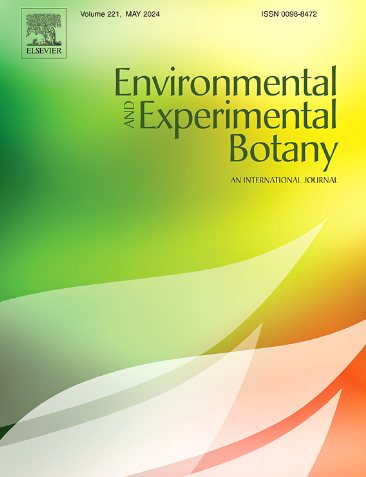OsYSL16启动子驱动的OsHMA3靶向表达降低了Cd在籽粒中的积累
IF 4.5
2区 生物学
Q2 ENVIRONMENTAL SCIENCES
引用次数: 0
摘要
通过遗传改良降低水稻籽粒镉含量是镉污染土壤中水稻生产的有效策略。在本研究中,我们以中早39号为材料,构建了OsYSL16启动子驱动OsHMA3靶向表达的转基因水稻株系。我们对转基因水稻品系与野生型(WT)植株在Cd处理下的表型和生理反应进行了比较分析。在0.1、1和10 μM Cd处理条件下,转基因水稻茎部Cd含量降低30% %以上。在10 μM Cd处理下,转基因水稻木质部汁液中的Cd含量显著低于WT植株。此外,转基因品系的茎部鲜重和干重提高了60% %以上,相应的根鲜重和干重提高了22.6% ~ 29.7% %。此外,与野生型植株相比,转基因植株的过氧化氢(H2O2)、丙二醛(MDA)含量、过氧化物酶(POD)和超氧化物歧化酶(SOD)活性显著降低。重要的是,与WT植株相比,转基因水稻植株根系中OsCAL1、OsIRT1、OsIRT2、OsNRAMP1和OsHMA2的表达水平显著降低。转基因水稻籽粒和叶片中的Cd含量以及Cd从叶片向籽粒的转运量均显著降低,籽粒Cd含量降低70% %以上。综上所述,OsYSL16启动子驱动的OsHMA3表达可有效抑制Cd从根到茎和从叶到籽粒的转运,最终减少Cd在籽粒中的积累。这为镉污染土壤水稻种植提供了一种新的策略,提高了食品安全和农业可持续性。本文章由计算机程序翻译,如有差异,请以英文原文为准。
Targeted expression of OsHMA3 driven by the OsYSL16 promoter decreases Cd accumulation in grains
Reducing cadmium (Cd) levels in rice grains through genetic improvement is an effective strategy for rice production in Cd-contaminated soils. In this study, we developed transgenic rice lines from Zhongzao39, featuring targeted expression of OsHMA3 driven by the OsYSL16 promoter. We conducted a comparative analysis to evaluate the phenotypic and physiological responses of transgenic rice lines versus wild-type (WT) plants under Cd treatment. Under 0.1, 1, and 10 μM Cd treatment conditions, transgenic rice plants exhibited a reduction of over 30 % in shoot Cd content. Notably, at 10 μM Cd treatment, Cd levels in the xylem sap of transgenic rice plants were significantly lower than those in WT plants. Additionally, shoot fresh weight and dry weight of the transgenic lines were increased by more than 60 %, while the corresponding root fresh weight and dry weight increased by 22.6–29.7 %. Furthermore, levels of hydrogen peroxide (H2O2), malondialdehyde (MDA), and activities of peroxidase (POD) and superoxide dismutase (SOD) were significantly lower in the transgenic lines compared to WT plants. Importantly, expression levels of OsCAL1, OsIRT1, OsIRT2, OsNRAMP1, and OsHMA2 in the roots of transgenic rice plants were significantly reduced compared to those in WT plants. The Cd contents in grains and leaves, as well as the transport of Cd from leaves to grains, were significantly lower in the transgenic rice plants, achieving a reduction in grain Cd content of over 70 %. Together, these results indicate that OsHMA3 expression driven by the OsYSL16 promoter effectively inhibits Cd translocation from roots to shoots and from leaves to grains, ultimately reducing Cd accumulation in grains. This provides a novel strategy for rice cultivation in Cd-contaminated soils, enhancing food safety and agricultural sustainability.
求助全文
通过发布文献求助,成功后即可免费获取论文全文。
去求助
来源期刊

Environmental and Experimental Botany
环境科学-环境科学
CiteScore
9.30
自引率
5.30%
发文量
342
审稿时长
26 days
期刊介绍:
Environmental and Experimental Botany (EEB) publishes research papers on the physical, chemical, biological, molecular mechanisms and processes involved in the responses of plants to their environment.
In addition to research papers, the journal includes review articles. Submission is in agreement with the Editors-in-Chief.
The Journal also publishes special issues which are built by invited guest editors and are related to the main themes of EEB.
The areas covered by the Journal include:
(1) Responses of plants to heavy metals and pollutants
(2) Plant/water interactions (salinity, drought, flooding)
(3) Responses of plants to radiations ranging from UV-B to infrared
(4) Plant/atmosphere relations (ozone, CO2 , temperature)
(5) Global change impacts on plant ecophysiology
(6) Biotic interactions involving environmental factors.
 求助内容:
求助内容: 应助结果提醒方式:
应助结果提醒方式:


